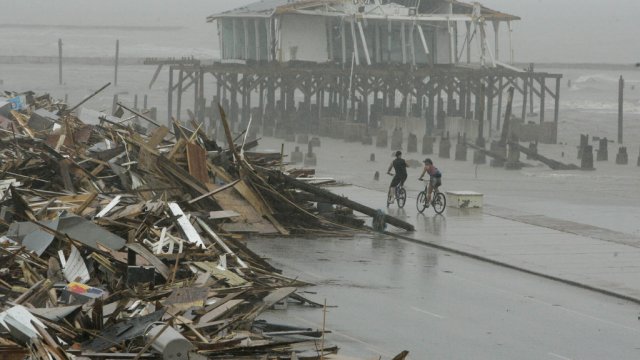Floridians hope that when Idalia hits the Gulf Coast it won't join the long list of destructive Atlantic Ocean storms whose names started with “I.”
Since 1955, 13 Atlantic storm names beginning with “I” have been retired, according to the National Weather Service. That happens when a storm’s death toll or destruction is so severe that using its name again would be insensitive, according to the World Meteorological Organization, which oversees storm naming.
SEE MORE: Hurricane Idalia to hit Florida with 'catastrophic' storm surge
Some letter has to be No. 1, and hurricane season often reaches its peak around the time that the pre-determined alphabetical storm-name list gets to the “I."
After “I” storms, 10 names that begin with “F” have been retired, as have nine storms beginning with “C,” University of Miami hurricane expert Brian McNoldy said.
In addition to the 13 retired “I” names from Atlantic Ocean hurricanes, a handful of Pacific Ocean storms beginning with “I” have been retired since 1982.
SEE MORE: Idalia not just a problem for Florida's Gulf Coast
The U.S. began using female names for storms in 1953 partly to avoid confusion and make warnings more efficient by using easy-to-remember names, according to the National Oceanic and Atmospheric Administration. Before then, radio stations used to broadcast warnings with numbers and names that confused people. By the late 1970s, male names were also being used for storms in the Atlantic and Pacific oceans, according to NOAA.
Notorious I-storms in recent memory have included:
Hurricane Isabel
The 2003 storm reached Category 5 strength over the Atlantic. Though it weakened before making landfall on North Carolina's Outer Banks, its winds caused extensive damage. More than 8 feet of seawater flooded rivers across the Chesapeake Bay region, according to accounts from the National Weather Service. The hurricane was blamed for 17 deaths.
Hurricane Ivan
Ivan tore through Grand Cayman island in 2004, damaging or destroying an estimated 95 percent of the buildings there, the National Weather Service said. Then, it slammed into the United States near Gulf Shores, Alabama, spawning more than 100 tornadoes as it moved inland. More than 92 people were killed.
Hurricane Ike
Ike “left a long trail of death and destruction” in Haiti, Cuba and the United States in 2008, the weather service said. An estimated 74 people in Haiti were killed by flooding and mudslides, the agency said. Later, it struck the U.S. as a Category 2 hurricane at Galveston Island in Texas.
SEE MORE: US hit by a record number of billion-dollar disasters so far this year
Hurricane Irma
Irma was the most powerful hurricane ever recorded in the open Atlantic Ocean when it took aim at several Caribbean islands in 2017, according to the National Weather Service. The Category 5 storm had sustained winds of up to 185 mph. As it approached Antigua, officials announced the closing of the airport with an ominous message: “May God protect us all.” Irma destroyed an estimated 90 percent of the structures on Barbuda, one of the hardest-hit islands. But several other islands, including Anguilla; the U.S. and British Virgin Islands; the French territory of St. Martin and the neighboring Dutch territory of St. Maarten all reported deaths and widespread damage.
Hurricane Ida
Ida slammed into the Louisiana coast with winds of up to 150 mph in 2021, knocking out power to hundreds of thousands of people across New Orleans and nearby parishes. The deaths included at least five nursing home residents who were among about 800 elderly residents sent to a warehouse to try and survive the storm.
Hurricane Ian
Ian struck Cuba as a major hurricane in 2022, bringing down the nation’s electric grid and causing blackouts across large parts of the island nation. Later, as a Category 4 hurricane, it slammed into Florida’s Gulf Coast, flooding houses on both coasts of the state, destroying reefs and bringing “red tide” algae to Gulf waters. Ian was blamed for more than 100 deaths, most of them in Florida.
Trending stories at Scrippsnews.com



